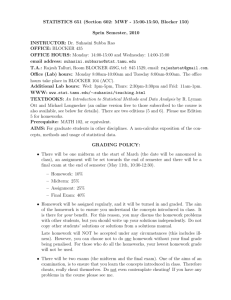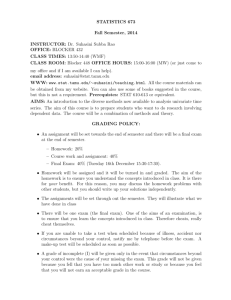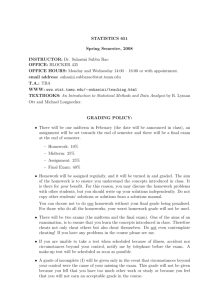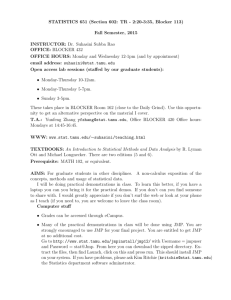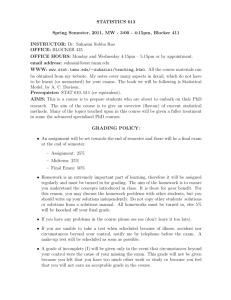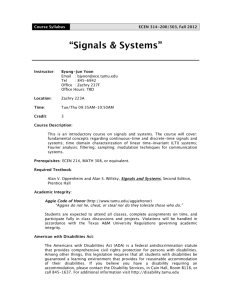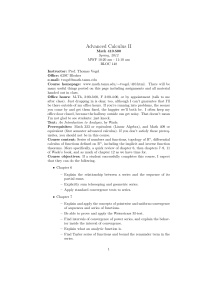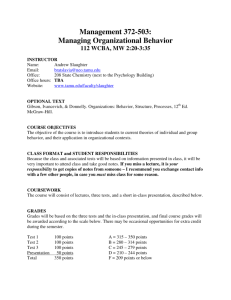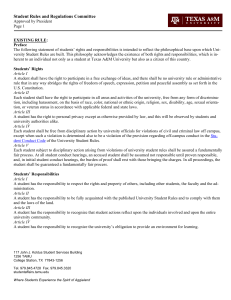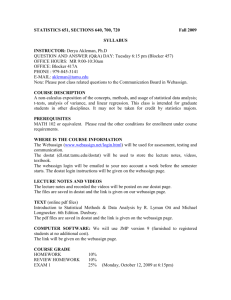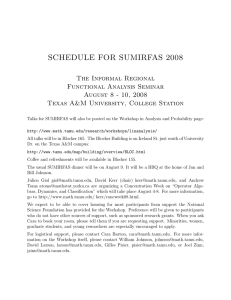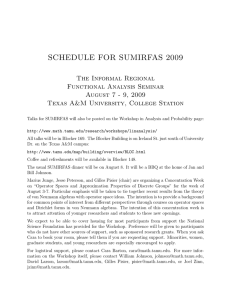Dr. Suhasini Subba Rao OFFICE
advertisement
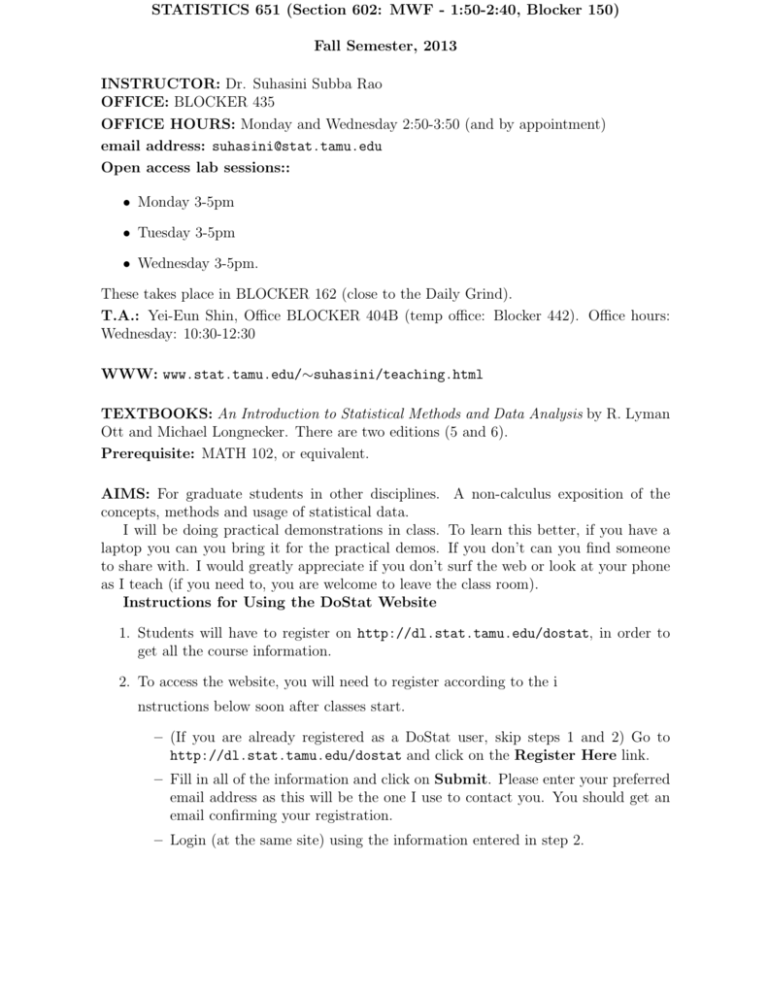
STATISTICS 651 (Section 602: MWF - 1:50-2:40, Blocker 150) Fall Semester, 2013 INSTRUCTOR: Dr. Suhasini Subba Rao OFFICE: BLOCKER 435 OFFICE HOURS: Monday and Wednesday 2:50-3:50 (and by appointment) email address: suhasini@stat.tamu.edu Open access lab sessions:: • Monday 3-5pm • Tuesday 3-5pm • Wednesday 3-5pm. These takes place in BLOCKER 162 (close to the Daily Grind). T.A.: Yei-Eun Shin, Office BLOCKER 404B (temp office: Blocker 442). Office hours: Wednesday: 10:30-12:30 WWW: www.stat.tamu.edu/∼suhasini/teaching.html TEXTBOOKS: An Introduction to Statistical Methods and Data Analysis by R. Lyman Ott and Michael Longnecker. There are two editions (5 and 6). Prerequisite: MATH 102, or equivalent. AIMS: For graduate students in other disciplines. A non-calculus exposition of the concepts, methods and usage of statistical data. I will be doing practical demonstrations in class. To learn this better, if you have a laptop you can you bring it for the practical demos. If you don’t can you find someone to share with. I would greatly appreciate if you don’t surf the web or look at your phone as I teach (if you need to, you are welcome to leave the class room). Instructions for Using the DoStat Website 1. Students will have to register on http://dl.stat.tamu.edu/dostat, in order to get all the course information. 2. To access the website, you will need to register according to the i nstructions below soon after classes start. – (If you are already registered as a DoStat user, skip steps 1 and 2) Go to http://dl.stat.tamu.edu/dostat and click on the Register Here link. – Fill in all of the information and click on Submit. Please enter your preferred email address as this will be the one I use to contact you. You should get an email confirming your registration. – Login (at the same site) using the information entered in step 2. – Click on the Add Course link to the left. – Fill in the course reference DS-595 and press Register. – Click My Account and edit your information as desired. Again, please indicate your preferred email address. GRADING POLICY: • There will be one midterm in November (the date will be announced in class), an assignment will be set towards the end of semester (around Thanksgiving) and there will be a final exam at the end of semester (Tuesday December 10th 2013, 8:00-10:00am). – Homework: 10% – Midterm: 25% – Assignment: 25% – Final Exam: 40% • Homework will be assigned regularly, and it will be turned in and graded. The aim of the homework is to ensure you understand the concepts introduced in class. It is there for your benefit. For this reason, you may discuss the homework problems with other students, but you should write up your solutions independently. Do not copy other students’ solutions or solutions from a solutions manual. Late homework will NOT be accepted under any circumstances (this includes illness). However, you can choose not to do two homeworks without your final grade being penalised. For those who do all the homeworks, your lowest homework grades will not be used. • There will be two exams (the midterm and the final exam). One of the aims of an examination, is to ensure that you learn the concepts introduced in class. Therefore cheats, really cheat themselves. Do not even contemplate cheating! If you have any problems in the course please see me. • At the end of November, I will set an assignment. You will have two weeks to complete it. This assignment is worth 25% of your final grade. • If you are unable to take a test when scheduled because of illness, accident nor circumstances beyond your control, notify me by telephone before the exam. A make-up test will be scheduled as soon as possible. • A grade of incomplete (I) will be given only in the event that circumstances beyond your control were the cause of your missing the exam. This grade will not be given because you fell that you have too much other work or study or because you feel that you will not earn an acceptable grade in the course. • No electronic devices should be used during the class. • STATEMENT ON DISABILITIES: The Americans with Disabilities Act (ADA) is a federal anti-discrimination statute that provides comprehensive civil rights protection for persons with disabilities. Among other things, this legislation requires that all students with disabilities be guaranteed a learning environment that provides for reasonable accommodation for their disabilities. If you believe you have a disability requiring an accommodation, please contact the Office of Support Services for Students with Disabilities in Room 126 of the Koldus Student Services Building. The phone number is 845-1637 • PLAGARISM STATEMENT: The handouts used in this course are copyrighted. By ”handouts,” I mean all materials generated for this class, which include but are not limited to syllabi, quizzes, exams, lab problems, in-class materials, review sheets, and additional problem sets. Because these materials are copyrighted, you do not have the right to copy the handouts, unless I expressly grant permission. As commonly defined, plagiarism consists of passing off as one’s own ideas, words, writing, etc., which belong to another. In accordance with this definition, you are committing plagiarism if you copy the work of another person and turn it in as your own, even if you should have the permission of that person. Plagiarism is one of the worst academic sins, for the plagiarist destroys the trust among colleagues without which research cannot be safely communicated. If you have any questions regarding plagiarism, please consult the latest issue of the Texas A&M University Student Rules, under the section ”Scholastic Dishonesty.” • ACADEMIC INTEGRITY STATEMENT: “An Aggie does not lie, cheat, or steal or tolerate those who do.” See also the Honor Council Rules and Procedures on the web. http://www.tamu.edu/aggiehonor Actually all the above is rather tedious to read. It can be summarised as follows, if you have any sense of decency, you would not bother to cheat. It’s just not worth it. • You are entitled to get JMP at no additional cost. Go to http://www.stat.tamu.edu/jmpinstall/ with Username = jmpuser and Password =install13c. From here you can download the zipped directory. Extract the files, then find Launch, click on this and press run. This should install JMP on your system. If you have problems ask Kim Ritchie our software adminstrator. SYLLABUS (Use this only a guide) Topic Chapter Number in Text of Lectures I Introduction and Data Description 1. What is Statistics? 2. Graphical Techniques for looking at data 3. Numerical measures for data 1,2,3 4 II Probability Distributions 1. Basic concepts for discrete and continuous random variables 2. Sampling distributions 3. Central limit theorem 4 4 III Confidence Intervals and Hypothesis Testing 1. Basic concepts of interval estimation 2. Basic concepts of hypothesis testing 3. Inference about a single mean 4. Inference about two means 5,6,7 5 IV Analysis of Categorical Data 1. Chi-square goodness of fit test 2. Inference about single proportions 3. r × c contingency tables 10 4 V One-way analysis of Variance 1. Basic notions behind ANOVA 2. F-test for equality of means 3. Model for one-way ANOVA 4. Nonparametric alternative 5. Introduction to multiple comparisons 8,9 5 VI Linear Regression and Correlation 1. Basic concepts of linear regression model 2. Correlation 3. Inference about regression parameters 4. Inference about mean of y 5. Prediction intervals at a given x 11,12 5
